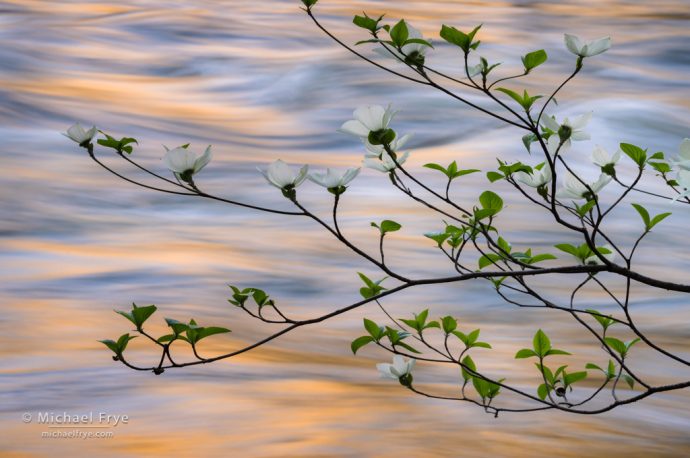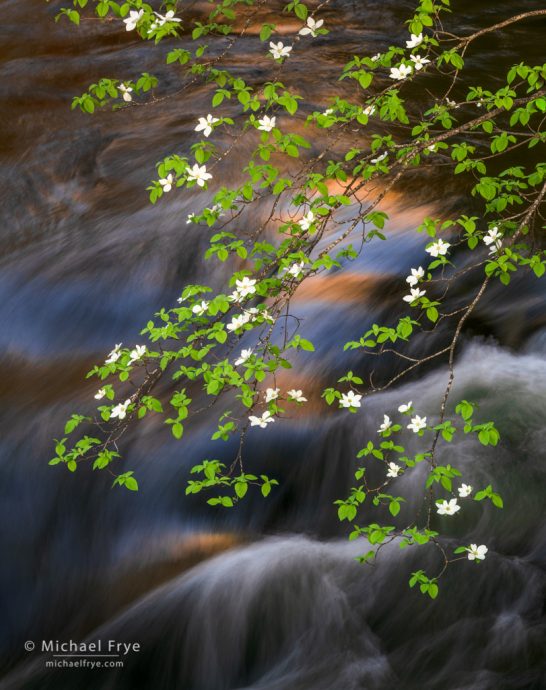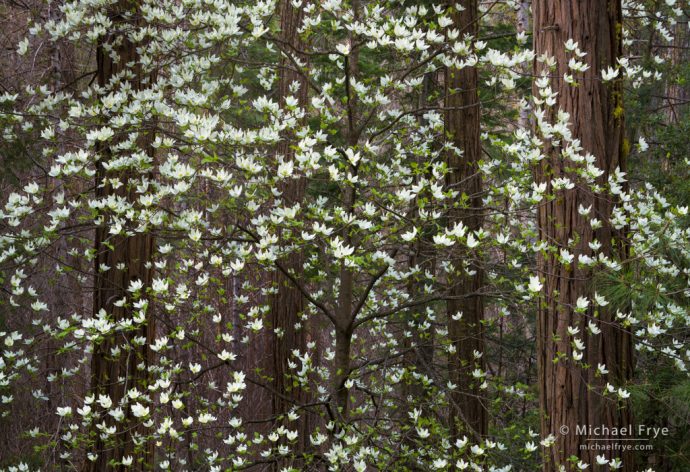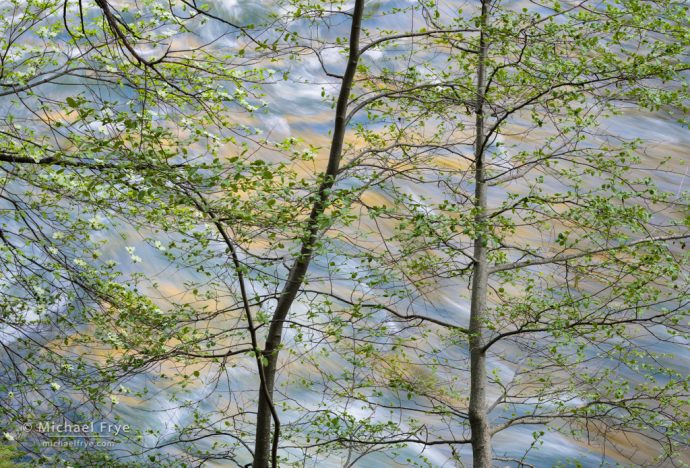
Dogwood and golden reflections, Yosemite. A telephoto lens (116mm) helped simplify the scene by isolating one small section of branches against the water. 1/4 second at f/22, ISO 100.
Claudia and I are up in the redwood country, scouting for our upcoming workshop. I’ll post some photos from this area later, but in the meantime here are a few more dogwood images from Yosemite.
One of the biggest challenges when photographing forest scenes, including dogwoods, is simplifying and organizing all the chaos. Trunks, branches, leaves, and shrubs are scattered about, growing where there’s sunlight and suitable soil. There’s an order to all that, but it’s an organic order that doesn’t translate easily into visual order. To find compositions that make sense, you have to look for ways to simplify these scenes.
Part of the problem is that you often can’t see the forest for the trees. I can’t count how many times I’ve spotted a promising forest composition, only to find that the view I wanted was obstructed by other trees or shrubs in the foreground. That’s why many of my best woodland photographs were made at the edge of a forest, where I can step back away from the trees without other trees getting in the way. You can find these edges along fields, meadows, roads, rivers, or lakes.
Another frequent problem is cluttered backgrounds. I always hope to find fog, because fog obscures the background and helps simplify the scene (and, as a bonus, can add a mystical mood). That’s also why I often try to photograph dogwoods against a river. With a slow shutter speed the water adds a soft, smooth, undistracting background so the dogwood branches and blossoms stand out clearly.
All the photographs shown here were made with telephoto lenses, because a long lens allows me to isolate a small, interesting part of a scene, and exclude potentially-distracting objects along the edges or in the background. Of course it’s possible to make strong, simple forest compositions with a wide-angle lens, but the ability to isolate and simplify with telephoto lenses is often extremely helpful when dealing with so much clutter.
And light always matters. In a forest, splotches of sun and shade create visual confusion, so soft light (shade or overcast) usually works better. Backlight can sometimes work as well. All the images here were taken in the shade.
Forests are compelling subjects, but challenging to photograph because of their clutter and complexity. In the end it boils down to three things: simplify, simplify, simplify.
— Michael Frye

Dogwood, rapids, and reflections, Yosemite. Again, using water as the background helped make the dogwood branches stand out. 0.6 seconds at f/16, ISO 100.

Dogwood and cedars, Yosemite. This dogwood grows along the edge of a road, which allowed me to stand back a bit, on the other side of the road, and photograph this pattern with a telephoto lens (93mm) without intervening branches. The background would be a cluttered mess if you could see it, but the thick mass of blossoms and leaves helps block the clutter. 0.7 seconds at f/16, ISO 100.

Alders and dogwood above the Merced River, Yosemite. Again, a telephoto lens (89mm) helped isolate an interesting pattern against a watery background. 1/4 second at f/16, ISO 160.
Related Posts: The Importance of Camera Position; Patterns, Focal Points, and Flowers
Michael Frye is a professional photographer specializing in landscapes and nature. He is the author or principal photographer of The Photographer’s Guide to Yosemite, Yosemite Meditations, Yosemite Meditations for Women, Yosemite Meditations for Adventurers, and Digital Landscape Photography: In the Footsteps of Ansel Adams and the Great Masters. He has also written three eBooks: Light & Land: Landscapes in the Digital Darkroom, Exposure for Outdoor Photography, and Landscapes in Lightroom: The Essential Step-by-Step Guide. Michael has written numerous magazine articles on the art and technique of photography, and his images have been published in over thirty countries around the world. Michael has lived either in or near Yosemite National Park since 1983, currently residing just outside the park in Mariposa, California.









I just returned from my first ever trip to the Redwoods. I’m glad to see that my experience was in line with what you encounter as well, Michael. Trying to simplify the clutter is not easy. But it is an amazingly beautiful place. Guess I’ll have to go back and try again next year. 🙂
I hope you enjoyed the trip anyway John, despite the photographic challenges. Fog helps immensely.
Gorgeous images. And thank you for sharing your data!
Thanks Evelyn!
Thank you for this, Michael. Here in the Northeast it’s always a challenge to make visual sense of our dense forests, and yours is a helpful and inspiring post.
Yes, the northeastern forests are pretty dense and cluttered. For inspiration you might look at some of the images of that region by Eliot Porter and Robert Glenn Ketchum.
Thanks, Michael, for these lovely images. Blooming dogwood in the Sierra always marks the return of spring for me. Early this month I had to return to the U.S. for a memorial service for a dear friend that died. Though sad, I got to visit my family up in the Sierra in Plumas Co. and the dogwood was in bloom! I got a few photos and enjoyed their beauty. I’ll be returning to the U.S. in July and am going to make a trip up to the Redwoods. I sure would like to take one of your workshops there—maybe someday. Thanks again.
Thanks Bob, and sorry to hear about your friend.
Michael,
As always, I learn something about composition from your photos and postings. Thank you for sharing the beauty and the knowledge…
Thanks Stan!
Beautiful images and some very helpful tips on isolating the subject. I like the first image best but I find the branch and partial flower at the top edge distracting. I’m sure you would have avoided it if possible. What were the circumstances that led you to that decision?
Thanks Carl. What were the circumstances that let me to that decision? Because that was the best alternative. Including more at the top would have included the opposite bank of the river. Cutting off more would have cut off the leaves and flowers near the top. I could have cloned out the branch, but that’s difficult, ethically questionable, and the branch actually adds a line that adds to the flow and repetition in the image.
Dear Michael, I never get tired of your dogwood blossoms with the the river in the background.
Vivienne
Thanks Vivienne!